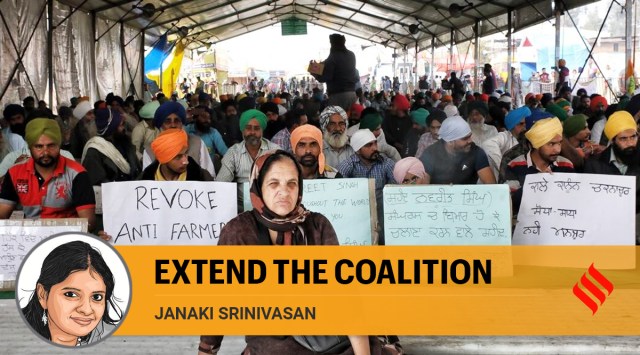- India
- International
Why the farmers’ movement must broaden its agenda
Janaki Srinivasan writes: It must demand transformations required in agriculture as part of a development model which can ensure livelihood, dignity and ecological restoration.
 Farmers in protest against the new Farm Bill at Singhu Border on February 09, 2021. (Express photo/Abhinav Saha)
Farmers in protest against the new Farm Bill at Singhu Border on February 09, 2021. (Express photo/Abhinav Saha)A number of developments in the past few weeks signal that state governments in the region at the epicentre of the ongoing farmers’ agitation have decided to shift the political conversation from the agitation. While former Punjab Chief Minister Amarinder Singh’s demand that the agitation be carried out only in Delhi and Haryana is admittedly the mildest move, the Uttar Pradesh government, despite being poll-bound, is banking on both the limited regional locus and caste dynamics of the agitation in addition to communal polarisation to blunt the electoral challenge posed by the farmers — despite the numbers of the Muzaffarnagar mahapanchayat. It is the Haryana government, however, where the ruling coalition’s MLAs and ministers have been unable to hold public functions or even enter their constituencies, that has determinedly moved away from its earlier characterisation of farmers as “misled” and adopted an aggressive approach.
Despite the flare-up in Karnal and its capitulation to the agitating farmers’ demands, the government has made fresh moves to clear the Delhi border and blamed the protests on Punjab and the Opposition parties. This points to a determined design to undermine the farmer-and-agriculture-infused political vocabulary that has been the mainstay of the state’s politics and requires us to enquire into the calculations that underpin it.
A number of policies adopted by the Haryana government in recent months offer vital clues. The most important of these, which has surprisingly found limited space in the farmers’ agitation, are the amendments the Haryana assembly brought in to the law governing land acquisition, rehabilitation and resettlement in the last week of August. It will come into force after obtaining the President’s Assent. While other states have brought in similar pieces of legislation, since 2016, to reverse critical provisions of the Central Right to Fair Compensation and Transparency in Land Acquisition, Rehabilitation and Resettlement Act (LARR), 2013, the Haryana had desisted till now. The state’s farmers were at the forefront of the protests to oppose the bid to amend LARR then. The INLD, JJP’s parent party, had opposed these amendments in Parliament: Then INLD MP and current deputy CM Dushyant Chautala’s impassioned speech in Parliament against the amendments he is now stoutly defending continues to be featured on JJP’s YouTube channel.
The amendments do away with the requirement of consent from 70 per cent of affected landowners in case of a Public Private Partnership (PPP) project and of Social Impact Assessment (SIA) for a range of public sector and PPP projects, including the malleable category of “infrastructure”, which defeats the limitation placed on the definition of “public purpose” permitting acquisition. It empowers the collector to unilaterally determine compensation without calling for objections or conducting an inquiry, thereby narrowing the category of “project affected” which the LARR had widened to include all those dependent on the land for their livelihood and residence.
 Social science scholarship on middle-caste peasantry in India, including of this Green Revolution belt, has pointed to the disjuncture between identity and aspiration that has come to characterise the landholding farming community since the turn of the century. While land remains a marker of identity, status and pride, aspirations of and for the youth (by the older generation) exhibit a disenchantment with farming and the desire for a salaried, preferably government, job or a desire to migrate abroad. As rising educational levels fail to translate into employment, both due to quality of education and shrinking employment opportunities, these communities have mounted agitations for inclusion in the OBC list, thereby qualifying for reservations in employment and education. Haryana was rocked by the Jat reservation agitation in 2016 by the very sections leading the current protests. In March, Haryana passed a law reserving 75 per cent of private sector jobs below the salary bracket of Rs 50,000 per month for domiciles.
Social science scholarship on middle-caste peasantry in India, including of this Green Revolution belt, has pointed to the disjuncture between identity and aspiration that has come to characterise the landholding farming community since the turn of the century. While land remains a marker of identity, status and pride, aspirations of and for the youth (by the older generation) exhibit a disenchantment with farming and the desire for a salaried, preferably government, job or a desire to migrate abroad. As rising educational levels fail to translate into employment, both due to quality of education and shrinking employment opportunities, these communities have mounted agitations for inclusion in the OBC list, thereby qualifying for reservations in employment and education. Haryana was rocked by the Jat reservation agitation in 2016 by the very sections leading the current protests. In March, Haryana passed a law reserving 75 per cent of private sector jobs below the salary bracket of Rs 50,000 per month for domiciles.

At one level, the recent amendments to LARR constitute a sop to an industry critical of this requirement. That Chautala spearheaded this law while facing intense pressure from his own party rank and file vis-à-vis the farm laws, however, signals that the plan is to go deeper and break the tenuous link between land and identity by casting the dice in favour of aspiration by broadening access to the urban industrial and services sector. This is part of a broader churning to undercut the evocative hold of the figure of the “farmer” in the political, especially electoral, discourse and centre politics around a post-agrarian economy.
The farmers’ agitation has garnered unprecedented solidarity from other social movements, mass organisations and trade unions including cautious support from those sections whose interests and caste experience lie in tension with landholding farmers. But to mount an effective challenge, this solidarity needs to translate into a coalition for which it needs to widen the agenda from return to status quo to the transformations required in agriculture as part of a development model which can ensure livelihood, dignity and ecological restoration. While the movement has taken an anti-corporate, anti-privatisation stand and some steps towards restoring broken communal harmony, it needs to have difficult conversations about caste and gender hierarchies in the agrarian social structure, and the prevailing ecologically unsound land-use patterns. It can take direction from the movement that led to LARR — anti-displacement movements had built alliances with other social movements, including that of farmers. The post-Green Revolution farmers’ movement in India has hitherto worked with a limited agenda but retaining its political salience necessitates such a dialogue.
This column first appeared in the print edition on September 21, 2021 under the title ‘Extend the coalition’. The writer teaches political science at Panjab University, Chandigarh
EXPRESS OPINION
More Explained
Apr 26: Latest News
- 01
- 02
- 03
- 04
- 05











































